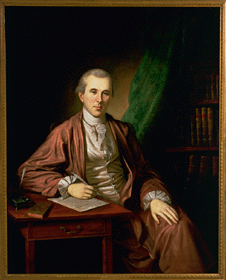 In answer to some of the student questions raised by my discussion of the state of medical practice in the 1790s, specifically as employed by Philadelphia physician Benjamin Rush, here are some answers.
In answer to some of the student questions raised by my discussion of the state of medical practice in the 1790s, specifically as employed by Philadelphia physician Benjamin Rush, here are some answers.I found an extensive discussion of the "explosively powerful" purgatives Rush used, and a picture of his medicine chest here. Calomel (a.k.a. mercury chloride) was apparently his favorite purgative. It used to be used in certain cosmetics as well as medicines, but that is illegal now. One source says it was also used for insecticides, but I imagine that is illegal now too, at least for household use.
On the amount of blood that might be drained from a patient, graduate student Roger Robinson found the following:
One typical course of medical treatment began the morning of 13 July 1824. A French sergeant was stabbed through the chest while engaged in single combat; within minutes he fainted from loss of blood. Arriving at the local hospital he was immediately bled twenty ounces (570 ml) "to prevent inflammation". During the night he was bled another 24 ounces (680 ml). Early next morning the chief surgeon bled the patient another 10 ounces (285 ml); during the next 14 hours he was bled five more times. Medical attendants thus intentionally removed more than half of the patient's normal blood supply - in addition to the initial blood loss which caused the sergeant to faint. Bleedings continued over the next several days. By 29 July the wound had become inflamed. The physician applied 32 leeches to the most sensitive part of the wound. Over the next three days there were more bleedings and a total of 40 more leeches. The sergeant recovered and was discharged on 3 October. His physician wrote that "by the large quantity of blood lost, amounting to 170 ounces [nearly eleven pints] (4.8 liters), besides that drawn by the application of leeches [perhaps another two pints] (1.1 liter), the life of the patient was preserved". By nineteenth-century standards, thirteen pints of blood taken over the space of a month was a large but not an exceptional quantity. The medical literature of the period contains many similar accounts-some successful, some not.
Delpech, M (1825). "Case of a Wound of the Right Carotid Artery". Lancet 6: 210-213.